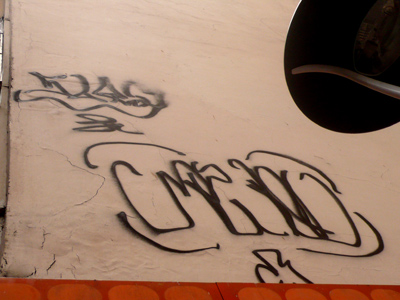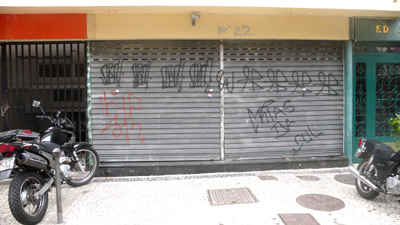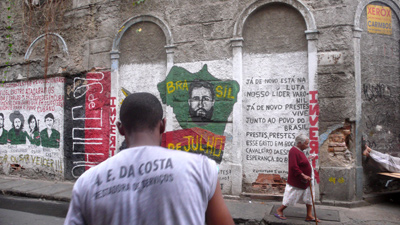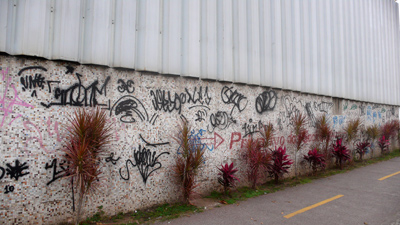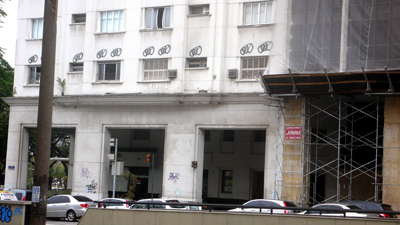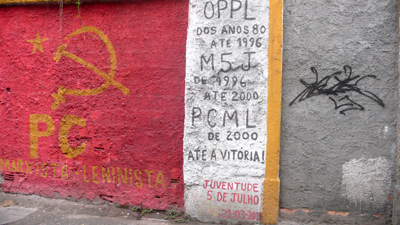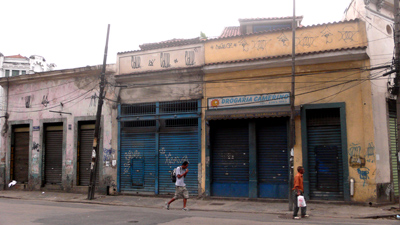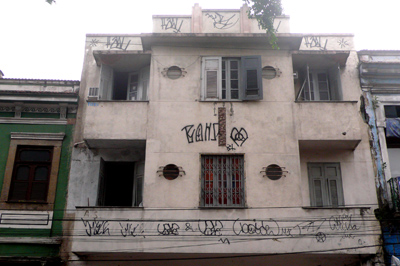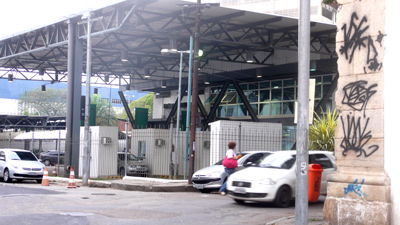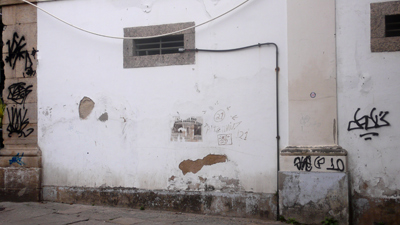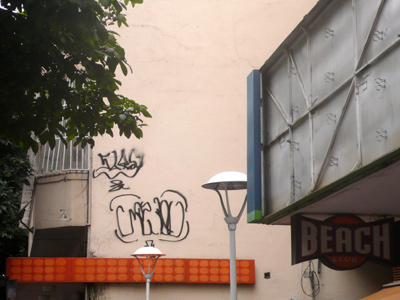On Graphic Crimes and Visible Fractures
Pixação is the Brazilian name for tagging, that is, for those unsolicited, unauthorized, and therefore criminal and disruptive graphic marks, written signs and emblems inscribed on walls and facades around the cities. It is distinguished from grafite (graffiti) by its hurried or “improvised” appearance, by the more limited visual vocabulary it displays (in part related to its origins in typographic styles and conventions) and its (apparent) absence of meaning other than the defiant gesture of defacing architecture and public and private spaces.
In Brazil, grafiteiros (graffiti makers or graffiti artists) paint walls and façades attempting to create relatively coherent visual symbols of different kinds, with diverse forms, using diversified strategies of elaboration, and with different degrees of success. The domain of grafite may approach mural painting at times.
Pixadores (tag or signature makers) on the other hand, attach their pre-developed marks and add inscriptions to surfaces. Their formal elaborations are more restricted in comparison, for the communicative power of their graphic creations rests on a shared code of meaning expressing a code of conduct that is indeed the central element to understand pixação as a form of activity and a form of sociability developed in the contemporary metropolis.
A pixador is evaluated for the amount of work, the extension of the urban area he is able to cover with his marks, but also according to the difficulties of access of the sites and the dangers he or she has incurred in the making of the works,
what demonstrates also the ability to avoid being caught by the police or by owners and residents of targeted buildings and areas. More often than not, the pixador who is caught will suffer moral and physical punishment in the hands of the captors, besides suffering legal penalties.
The graphic marks, signs and emblems of pixação adapt the forms and images of current language, and recreate everyday codes into a specialized group language. For those outside it, that is, the majority of the population of the cities, they appear as meaningless scribbles, disruptive, aggressive acts, purely destructive gestures adding “rubble upon rubble”, that is adding the fragments of visual and linguistic codes to an already fragmented and dilapidated body of the city,
such as abandoned structures, decayed areas, vacant lots and their walls, etc, or attacking public and private buildings and structures in central areas of the city and marking them with the language of decayed codes and the appearance of decomposing surfaces.
To the insiders, the pixadores and their fellows and followers, as they re-signify the space of the city, these marks re-signify and re-evaluate their makers.
The essential changes in the organization and functioning of capitalism in the late part of the 20th century were summarized by Baudrillard in the concept of a Semiocracy. When the production and circulation of signs becomes the essential economic process of hyper-capitalism, a struggle to signal/signalize/signify the city becomes a new front in which the imposition of a signifying logic meets the resistance of new, fractionated and unstable signifiers.
To Baudrillard the logic of exclusion and ghettoisation is indeed the universal logic of capitalism embodied in the postmodern city with its functional organization and compartmentalization of the physical and the social space and its fractioning of life: the city itself is a space segregated from its inhabitants, it is the organization of generalized segregation as a way of life and as a mode of production.
Graffiti and tag both refashion and subvert, that is, mirror and invert the spatial, visual, structural codes of the Hyper-city. They make visible the boundaries, borderlines, and inner frontiers structuring the life of the cities today as places of fracture of meaning and action.
text by Marcelo Lima, Dubai, November 2010
images by Rayelle Niemann, Rio de Janeiro, Brazil, September 2010
On Graphic Crimes and Visible Fractures
RELATED WEB SITES
→ author’s blogspot
→ artist’s web-site
[ Abou Naddara ]
[ Accessible Approach ]
[ Beyrouth ]
[ Cairo as Canvas ]
[ Dawam al hal min al muhal—No Condition is Permanent ]
[ De Montmorency à Metz ]
[ Dowry No ]
[ Fear of a Muslim Planet ]
[ Fragmented Letters ]
[ Gentle Wall project ]
[ Images and Images ]
[ Kafranbel ]
[ Leading a Smart Revolution ]
[ Lens of a young Person ]
[ Muraqabet amel jidariya—Watching the Creation of a Wall Painting ]
[ No Holy Cows ]
• On Graphic Crimes and Visible Fractures •
[ on going ]
[ PMS = Poster Message Service ]
[ Réconciliation ]
[ Rasael—Messages ]
[ Seipone ]
[ T.W.B.T.C ]
[ This is a picture book ]
[ Vitry ]
[ What remains and Things to come ]
FEATURED THEME ON CITY SHARING
by ASUNCION MOLINOS GORDO
-
This project is an instrument for common critical analysis to help understand the reasons behind Egyptians’ diminishing …
by INAS HALABI
-
The project Letters to Fritz and Paul focuses on the expeditions of the Swiss cousins, lovers and scientists, Fritz and …
by SARAH BURGER
-
The planned modern city of Brasilia attracted me since a long time. Her defined shape, location and function proceded he …
by ADRIEN GUILLET
-
Youri Telliug talks with the artist Adrien Guillet about his project Citracit
Youri Telliug - What is Citracit …
by NIGIST GOYTOM
-
In 2013 more than 45 million people have been forced to leave their homes. This amounts to the biggest number of refugees …
by SULAFA HIJAZI
-
The on going debate on Arab identity and its (cultural) representation is strongly shaped by Edward Saidʼs formative …
by ASUNCION MOLINOS GORDO
-
WAM is a site-specific work that uses the historical trope of the cabinet of curiosities to explore the introduction of …
MORE CONTRIBUTIONS BY THE FOLLOWING
